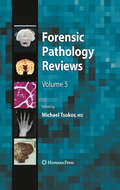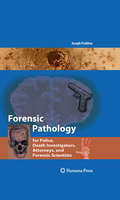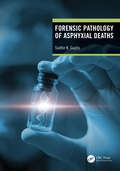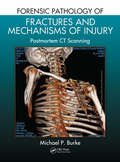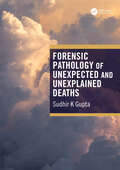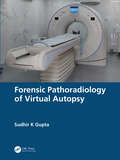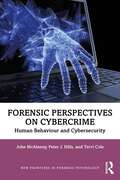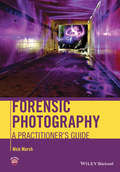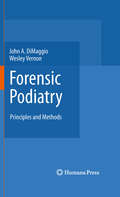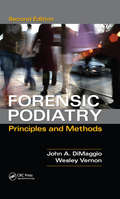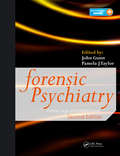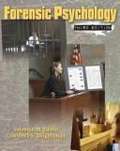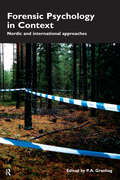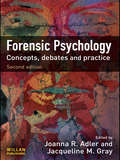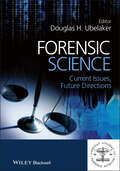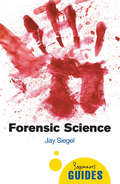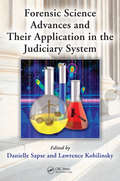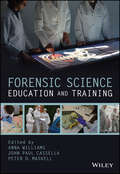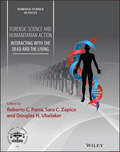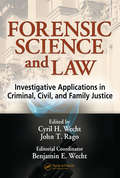- Table View
- List View
Forensic Pathology Reviews 5
by Michael TsokosIn this new volume of the globally recognized Forensic Pathology Reviews, Dr. Michael Tsokos has gathered chapters from the top experts in the field to reveal both the applied and scientific areas of expertise along the broad spectrum of forensics studies. Volume 5 piques the mind as leading forensic pathologists from the United States and around the world offer advanced insight into death caused environmental conditions, trauma, neuropathology, natural causes, and ballistics. The authors of this volume further their exploration as they impart research related to identification, serial murder, histopathology, and age estimation. While unveiling unsurpassed and cutting-edge knowledge, Forensic Pathology Reviews, Volume 5 will also inspire emerging forensic scientists to immerse themselves in innovative research.
Forensic Pathology for Police, Death Investigators, Attorneys, and Forensic Scientists
by Joseph A. PrahlowForensic Pathology for Police, Death Investigators, Attorneys, and Forensic Scientists is a forensic pathology book specifically written for professionals who interact with forensic pathologists. The book includes sections that address various general topics which are not normally present in the typical forensic pathology text, such as descriptions of medical, pathology and forensic pathology training, basic anatomy and physiology, an overview of other forensic science disciplines, and autopsy performance. Forensic Pathology for Police, Death Investigators, Attorneys, and Forensic Scientists also covers classic topics in forensic pathology, including death investigation, death certification, postmortem changes, and the entire range of case types, ranging from natural deaths to drug-related deaths to various types of violent death. The text is written in easy-to-understand language, and is complemented by hundreds of high-quality photographs.
Forensic Pathology of Asphyxial Deaths
by Sudhir K GuptaThis book provides an overview of Asphyxial Deaths which includes hanging, strangulation, choking, smothering, gagging, drowning, aspiration, mechanical and chemical asphyxiants, etc. Postmortem examination often leads to doubts as a clear distinction between the different type of asphyxia cannot be made easily. Forensic and physiological aspects are discussed with the help of illustrative cases. The author discusses the different aspects of asphyxia deaths and substantiates multiple case studies to establish a scientific approach that can act as a guideline to the autopsy surgeon in providing a precise opinion and clarify doubts for the judiciary involved in such criminal justice cases. Key Features• Presents individual case studies of Asphyxial deaths. • Covers the guidelines to be followed by the autopsy surgeons in different cases.• Discusses the physiological aspects of Asphyxial deaths in detail.• Illustrates the cases in a stepwise manner with more than 350 colored photographs of postmortem examination.
Forensic Pathology of Fractures and Mechanisms of Injury: Postmortem CT Scanning
by Michael P. BurkePractitioners of forensic medicine have various tools at their disposal to determine cause of death, and today‘s computed tomography (CT) can provide valuable clues if images are interpreted properly. This volume is a guide for the forensic pathologist who wants to use CT imaging to assist in determining the mechanism of injury that might have contributed to death. Enhanced with hundreds of CT images that clarify the text and case studies to put the material in context, the book gives a head-to-toe catalogue of various injuries and how they are represented on a CT scan.
Forensic Pathology of Infancy and Childhood
by Roger W. Byard Kim A. CollinsThe investigation of sudden or unexplained death of children represents a unique medical and forensic area of study. Children have unique anatomic and functional characteristics that must be recognized and understood by the medical investigator. Further complicating this process is the fact that the anatomic structure, composition and function of various organs and organ systems in the pediatric population change throughout the developmental stages of childhood. The disease processes, reactions to trauma and risk factors for accidental death and homicide change from infancy through adolescence. "Forensic Pathology of Infancy and Childhood" provides an authoritative, comprehensive reference text devoted to the medicolegal investigation of sudden unexpected death in children. With contributions from internationally renowned experts, individual chapters focus on specific unique causes and organ systems with detailed accounts of the changes in fatal diseases, risk factors of causes of sudden death, and responses to fatal trauma that occur as a child grows from neonatal stage through infancy, toddlerhood, childhood and adolescence. This text is an essential reference resource for forensic pathologists, medical examiner offices, pediatric pathologists, pediatric hospitals, anatomic pathologists and those in training as well as those in related legal professions. "
Forensic Pathology of Unexpected and Unexplained Deaths
by Sudhir K GuptaForensic Pathology of Unexpected and Unexplained Deaths addresses one of the most complex challenges in forensic medicine—sudden, unexpected, and unexplained deaths. These cases present unique difficulties for forensic teams, requiring meticulous investigation and analysis.This authoritative text provides a critical examination of postmortem findings. It incorporates radiological imaging and histopathological features to enhance forensic diagnosis, exploring possible causes of death and the medico-legal considerations essential to forensic investigations. The book delves into verbal, virtual, and molecular autopsy techniques, equipping forensic professionals with the tools needed to navigate complex cases with precision.An essential resource for postgraduate students in Forensic Medicine and Toxicology, it is also invaluable for practitioners working in forensic pathology, law enforcement, and the legal system. Through a combination of case-based discussions, advanced forensic methodologies, and detailed illustrative content, Forensic Pathology of Unexpected and Unexplained Deaths serves as a definitive guide to the investigation and interpretation of sudden deaths.
Forensic Pathoradiology of Virtual Autopsy
by Sudhir K GuptaVirtual autopsy is a burgeoning field that employs imaging methods to find the cause of death. This book critically analyses and compares different post-mortem features and their radiological appearance in diverse cases. It orients the forensic doctors trained in traditional autopsy to understand the radiological appearance of their gross findings and the radiologists to comprehend the pathology in an imaging study. Further, it provides the standard operating protocols to be followed in different cases. This can be an alternative to standard autopsies for broad and systemic examination of the whole body as it saves time, aids better diagnosis, and respects religious sentiments. Key features: Provides the reader with an in-depth review of the value of a CT-directed virtual autopsy complementing a regular autopsy and how it can enhance the quality of medico-legal death investigation in a jurisdiction. Bridges the gap between the specialities of Forensic Medicine and Radiology and helps the readers co-relate and understand the concept of Virtual Autopsy. Features over 500 original autopsy photographs and CT images with over 100 case reports including a stepwise approach to each case along with comparative radiological images.
Forensic Perspectives on Cybercrime: Human Behaviour and Cybersecurity (New Frontiers in Forensic Psychology)
by Peter J. Hills Terri Cole John McAlaneyForensic Perspectives on Cybercrime is the first book to combine the disciplines of cyberpsychology and forensic psychology, helping to define this emergent area. It explores the psychological factors that influence the behaviour of all those involved in cybersecurity, drawing upon the research literatures in relevant areas including forensic, social, and cyberpsychology.Written by leading figures in the field, the book provides an introduction to the cybercrime ecosystem, before discussing the psychological manipulation of targets through social engineering techniques and highlighting the unique threats that this type of attack presents. The reasons why people become involved in hacking are explored, and the authors review research literature on risk factors of being a victim of cybercrime, along with the concept of resilience. Behaviour change and prevention strategies are also evaluated, as well as the role of emergent technologies such as artificial intelligence and what this may mean for the role of humans in cybersecurity. Case studies and real-world examples are woven throughout to illustrate key issues, opportunities, and challenges.This unique text is a must-read for students undertaking any degree that relates to behaviour and cybersecurity, including psychology, computing, law, and business management. It is also highly relevant to researchers, practitioners, and policymakers who work in cybersecurity and/or have an interest in empowering people to be safe online.
Forensic Photography
by Nick MarshForensic photography plays a vitally important part in the investigation of crime and the subsequent administration of justice. Written by a practitioner with many years professional experience, this book provides an overview of the most common forensic photography techniques in use today for those readers who may not have a detailed understanding of camera techniques and who need to get to grips with the use of light and other key scientific aspects of the job. It covers image capture issues, file handling and relevant equipment, such as lasers and UV lights, and explores how they work. The predominance of the digital camera has resulted in an increasing trend for police forces across the world to use untrained camera users, rather than expert photographers. Therefore, this book will prove invaluable for those practitioners who need to produce accurate and clear photographic evidence, above and beyond the point and shoot mode on their cameras.
Forensic Podiatry
by John A. Dimaggio Wesley Vernon ObeThe human foot is a complex body part composed of fifty-two bones, which is twenty-five percent of all the bones in the body. Nonetheless, the foot is often viewed by the public and doctors as a "minor" body part. Similarly, the importance of pedal evidence in crime investigation has also long been undervalued, but as footwear evidence has become more commonly used in forensic situations, so has pedal evidence, which is why this seminal work is so important: it is the first textbook ever dedicated to forensic podiatry. Forensic Podiatry is an international compilation of current practices authored by the pioneers in the field. Part I discusses general forensic concerns, including those at the crime scene, from an informative perspective. It covers tasks performed by the crime laboratory, forensic podiatry principles, and various aspects of human identification. Part II deals with specific forensic podiatric concerns such as photographic techniques, bare footprint identification, and footwear examination and analysis. It also discusses forensic gate and analysis as well as the identification of pedal remains from podiatry records, which is important for mass disaster scenes. Part III presents actual forensic podiatry case studies from the United Kingdom and the United States, and Part IV focuses on podiatry practice standards, which in many instances parallel expert witness responsibilities. Groundbreaking and essential, this book is useful for medical and criminal justice students as well as podiatrists, criminalists, footwear examiners, forensic anthropologists, attorneys and investigators.
Forensic Podiatry: Principles and Methods, Second Edition
by Denis Wesley Vernon John A. DiMaggioForensic Podiatry: Principles and Methods, Second Edition has been completely updated to reflect the latest developments and advancements in this changing field. New additions to the book, from the previous edition, include all new chapters on the expert witness, Frye Test, and Daubert Standard, as well as revised theories on gait analysis, bare footprint identification, and footwear examination. The new edition includes extensive case studies and an international compilation of current best practices. Since this text’s first publication, the field of forensic podiatry has rapidly developed from relative obscurity to a dynamic, internationally recognized discipline. Forensic podiatrists have been able to advance improvements in the field, both in widening the range of applications and deepening the practice through improved techniques to strengthen evidentiary conclusions. Written by two pioneers in the field, Forensic Podiatry includes over one hundred detailed illustrations to serve as an invaluable resource for students, practicing forensic podiatrists, legal professionals and those new to the profession.
Forensic Psychiatry: Clinical, Legal and Ethical Issues, Second Edition
by John Gunn Ian D. Hutcheon Pamela TaylorHighly Commended, BMA Medical Book Awards 2014Comprehensive and erudite, Forensic Psychiatry: Clinical, Legal and Ethical Issues, Second Edition is a practical guide to the psychiatry of offenders, victims, and survivors of crime. This landmark publication has been completely updated but retains all the features that made the first edition such a w
Forensic Psychology
by Solomon M. Fulero Lawrence S. WrightsmanWritten by two of the leading authorities in the field, FORENSIC PSYCHOLOGY, Third Edition introduces you to the practice of forensic psychology by showing how psychologists aid the legal system by serving as expert witnesses, criminal profilers, and trial consultants for jury selection and child custody hearings. Wrightsman and Fulero present the roles and responsibilities of forensic psychologists, and address both the opportunities and temptations inherent in those roles. Through this lens, the authors explore the ethical issues facing practicing forensic psychologists, such as promising clients too much, the possibility of becoming advocates rather than objective scientists, and the pitfalls associated with substituting one's values for data. The authors provide an accurate and candid picture of the field, and the range of careers in forensic psychology.
Forensic Psychology in Context: Nordic and International Approaches
by P. A. GranhagAcademics and researchers from the Nordic countries (Sweden, Iceland, Norway, Finland) have made a particularly strong contribution internationally to the rapidly developing disciplines of forensic and legal psychology. This book brings together the leading authorities in the field to look systematically at the central issues and concerns of their subject, looking at both investigative psychology and psychology in court. Forensic Psychology in Context reflects the results of research in the Nordic countries themselves, but each chapter situates this work within a broader comparative and international context. The book is a major contribution to the subject, and will be essential reading for anybody with interests in this field.
Forensic Psychology: Concepts, Debates and Practice
by Joanna R. Adler Jacqueline M GrayThis book brings together academics, practitioners and experts in the field of forensic psychology to demonstrate the scope of the discipline and push its parameters. Its aim is to go beyond introductory texts to challenge perceptions, to raise questions for research and to pose problems for practice. The editors hope to inspire and stimulate debate about how forensic psychology can aid the practice of justice. The book is divided into six sections, addressing key topics from the discipline: investigation and prosecution; testimony and evidence; serious and persistent offending; treatment as intervention; intervention and prevention and punishment and corrections. The contributors are drawn from the UK, the USA and Australia.This updated, revised and significantly expanded edition develops the picture of diversity and depth of forensic psychology; considers ways in which the discipline has progressed and identifies challenges for its future sustainability and growth. includes a new section on treatment as intervention with contributions on personality disordered offenders; anger control group work with forensic psychiatric inpatients; and developments in treatment for drug misuse offenders additional chapters throughout including contributions on UK police interviews; the investigation and prosecutoin of rape; the effect of gender in the courtroom; forensic psychology and terrorism; the aetiology of genocide; self harm in prisons; post-corrections reintegration and many more an innovative textbook on forensic psychology exploring application of the subject and setting forensic psychology in a broader context demonstrates ways in which forensic psychology can aid the practice of criminal justice This book will be essential reading for students of forensic psychology and practitioners working in the field.
Forensic Science
by Douglas H. UbelakerCo-published with the American Academy of Forensic Sciences, Forensic Science presents comprehensive international discussion of key issues and future directions within the forensic sciences. Written by accomplished and respected specialists in approximately eleven distinct areas of the forensic sciences, the volume will examine central issues within each discipline, provide perspective on current debate and explore current and proposed research initiatives. It will also provide the forensically involved international community with current in-depth perspective on the key issues in the contemporary practice of the forensic sciences.
Forensic Science
by Jay SiegelIn the wake of the phenomenal success of such shows as CSI, forensic science has never been so popular. The obsessive attention to detail that Grissom and his crew afford seemingly insignificant details, such as particles of dirt in a bullet wound and the presence of pollen in tyre tracks, have had audiences eager to know more. Siegel's study follows the course of evidence all the way from the crime scene right through to the court judgement, investigating the many types of evidence, how they occur in crimes, how they are collected and analyzed by scientists, and how the results are presented in court. Packed with real examples, the book covers all the major areas of forensic science including drugs, trace evidence, pathology, entomology, odontology, anthropology, crime scene investigation, and law.
Forensic Science Advances and Their Application in the Judiciary System
by Lawrence Kobilinsky Danielle SapseThis volume examines how new cutting edge forensic techniques are currently being applied or have the potential to be applied in judicial proceedings. Examples include new applications of Raman spectroscopy, quantum chemistry, lithium in DNA analysis, and the burgeoning area of toxicogenetics. In each case legal issues are addressed, including the
Forensic Science Education and Training
by Anna Williams John Paul Cassella Peter D. MaskellA comprehensive and innovative guide to teaching, learning and assessment in forensic science education and practitioner training Includes student exercises for mock crime scene and disaster scenarios Addresses innovative teaching methods including apps and e-gaming Discusses existing and proposed teaching methods
Forensic Science Glossary
by John C. BrennerIn forensics, there is often a difficulty conveying critical scientific terms to investigators, attorneys, juries, and even court reporters. Forensic Science Glossary is a single source reference that contains the spelling and definitions of commonly used terms found in forensic environments. This glossary of words and their meanings covers importa
Forensic Science Handbook, Volume I
by Richard Saferstein Adam B. HallOriginally published in 1982 by Pearson/Prentice-Hall, the Forensic Science Handbook, Third Edition has been fully updated and revised to include the latest developments in scientific testing, analysis, and interpretation of forensic evidence. World-renowned forensic scientist, author, and educator Dr. Richard Saferstein once again brings together a contributor list that is a veritable Who’s Who of the top forensic scientists in the field. This Third Edition, he is joined by co-editor Dr. Adam Hall, a forensic scientist and Assistant Professor within the Biomedical Forensic Sciences Program at Boston University School of Medicine. This two-volume series focuses on the legal, evidentiary, biological, and chemical aspects of forensic science practice. The topics covered in this new edition of Volume I include a broad range of subjects including: • Legal aspects of forensic science • Analytical instrumentation to include: microspectrophotometry, infrared Spectroscopy, gas chromatography, liquid chromatography, capillary electrophoresis, and mass spectrometry • Trace evidence characterization of hairs, dust, paints and inks • Identification of body fluids and human DNA This is an update of a classic reference series and will serve as a must-have desk reference for forensic science practitioners. It will likewise be a welcome resource for professors teaching advanced forensic science techniques and methodologies at universities world-wide, particularly at the graduate level.
Forensic Science Laboratory Benchmarking: The FORESIGHT Manual
by Max M. Houck Paul J. SpeakerForensic Science Laboratory Benchmarking: The FORESIGHT Manual takes a step-by-step instructional approach to utilizing FORESIGHT data, detailing how labs can participate in the process to improve efficiencies. The FORESIGHT Project—a business benchmarking process for forensic service providers—was created in 2008 to collect and report data while offering improvement to processes through analysis, comparisons, and best practice evaluations. The program has grown to include more than 200 participating forensic laboratories worldwide.FORESIGHT offers the capability for labs to improve core functions, provide and benefit from metrics, and thus, improve the labs capabilities and functioning for the public good, while maintaining their often limited, fixed budgets. Due to ever-increasing caseloads, forensic laboratories are constantly plagued by backlogged casework—cases submitted to the laboratory but not yet worked. This leads to inefficiencies, delays, and unhappy agencies expecting timely results. Unfortunately, even if a lab’s slates were wiped clean and the backlog were erased, many of the inefficient processes—that created the backlog—would still be in place. Eventually, and inevitably, the lab would develop a new backlog.Unique coverage and features: Presents critical and proven cutting-edge measures to utilize FORESIGHT data improve laboratory testing, operational efficiency, and policies without added additional costs. Synthesizes the data input from more than 200 labs and a decade’s worth of analytics to illustrate process improvements and the advantages of participating. Outlines how to develop data-driven responses to solve current and future problems. Forensic Science Laboratory Benchmarking will be of interest to quality assurance specialists, economists, supervisors in the parent agencies of the labs, managers at all levels of any of the hundreds of public laboratories around the world, and anyone concerned about the effectiveness and efficiency of laboratory testing. As an operational guide, the book provides a helpful roadmap to help public science agencies and forensic labs analyze how they operate, improve on what works, and change what doesn’t to better meet their mission and serve their community’s goals.
Forensic Science Laboratory Manual and Workbook
by Thomas Kubic NICHOLAS PETRACOA laboratory companion to Forensic Science: An Introduction to Scientific and Investigative Techniques and other undergraduate texts, Forensic Science Laboratory Manual and Workbook, Third Edition provides a plethora of basic, hands-on experiments that can be completed with inexpensive and accessible instrumentation, making this an ideal workbook f
Forensic Science and Humanitarian Action: Interacting with the Dead and the Living (Forensic Science in Focus #17)
by Douglas H. Ubelaker Roberto C. Parra Sara C. ZapicoWidens traditional concepts of forensic science to include humanitarian, social, and cultural aspects Using the preservation of the dignity of the deceased as its foundation, Forensic Science and Humanitarian Action: Interacting with the Dead and the Living is a unique examination of the applications of humanitarian forensic science. Spanning two comprehensive volumes, the text is sufficiently detailed for forensic practitioners, yet accessible enough for non-specialists, and discusses both the latest technologies and real-world interactions. Arranged into five sections, this book addresses the ‘management of the dead’ across five major areas in humanitarian forensic science. Volume One presents the first three of these areas: History, Theory, Practice, and Legal Foundation; Basic Forensic Information to Trace Missing Persons; and Stable Isotopes Forensics. Topics covered include: Protection of The Missing and the Dead Under International Law Social, Cultural and Religious Factors in Humanitarian Forensic Science Posthumous Dignity and the Importance in Returning Remains of the Deceased The New Disappeared – Migration and Forensic Science Stable Isotope Analysis in Forensic Anthropology Volume Two covers two further areas of interest: DNA Analysis and the Forensic Identification Process. It concludes with a comprehensive set of case studies focused on identifying the deceased, and finding missing persons from around the globe, including: Forensic Human Identification from an Australian Perspective Skeletal Remains and Identification Processing at the FBI Migrant Deaths along the Texas/Mexico Border Humanitarian Work in Cyprus by The Committee on Missing Persons (CMP) Volcán De Fuego Eruption – Natural Disaster Response from Guatemala Drawing upon a wide range of contributions from respected academics working in the field, Forensic Science and Humanitarian Action is a unique reference for forensic practitioners, communities of humanitarian workers, human rights defenders, and government and non-governmental officials.
Forensic Science and Law: Investigative Applications in Criminal, Civil and Family Justice
by Cyril H. Wecht John T. RagoForensic science has undergone dramatic progress in recent years, including in the areas of DNA collection and analysis and the reconstruction of crime scenes. However, too few professionals are equipped with the knowledge necessary to fully apply the potential of science in civil, criminal, and family legal matters.Featuring contributions from
